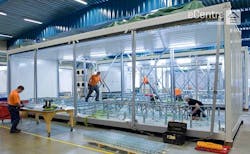Edge is Eating Away at the Cloud, and The Data Center Will Benefit
I really hope you’re not sick of this “edge” term yet, because edge solutions aren’t going anywhere. Edge computing is something I’ve been discussing quite a bit and have done a lot of research around as well. Before we go on too much further, let’s start with a high-level definition of the edge.
The goal of Edge Computing is to allow an organization to process data and services as close to the end-user as possible.
That’s it. It’s really as simple as that. Now, beyond that one-sentence definition, there are a lot of use-cases, and a lot of investment and growth around edge solutions as data center leaders continue to invest more in these kinds of architectures. Here’s an example: In February, Compass Datacenters acquired two companies that make Compass the first provider in the data center industry that can deliver dedicated mission critical facilities from the core to the edge – all with a common management and service platform. The companies that have been acquired are EdgePoint Systems, which delivers, installs and maintains fully-integrated edge data centers anywhere they are required, and BitBox USA, a pioneering facility management platform and solutions integrator specifically tailored for the edge.
Make no mistake, these kinds of solutions aim to dramatically simplify the implementation and on-going operation of everything from a single campus to multiple edge locations.
“Organizations that have embarked on a digital business journey have realized that a more decentralized approach is required to address digital business infrastructure requirements,” says Santhosh Rao, principal research analyst at Gartner. “As the volume and velocity of data increases, so too does the inefficiency of streaming all this information to a cloud or data center for processing.”
Edge solutions are offering greater amounts of flexibility and opening up a world of use-cases when it comes to working with distributed data points and users.
Edge is Eating Away at the Cloud
There was an interesting blog from Gartner which stated the following: “Today, cloud computing is eating enterprise data centers, as more and more workloads are born in the cloud, and some are transforming and moving to the cloud. But there’s another trend that will shift workloads and data and processing and business value significantly away from the cloud. The edge will eat the cloud. And this is perhaps as important as the cloud computing trend ever was.”
First, we saw massive centralization of IT and resources, and now we’re seeing the distribution and vast decentralization of even more data and resources. Honestly, I’m not surprised.
I don’t believe that edge is necessarily “eating” away at the cloud. Rather, we’re seeing an expansion of capabilities where data center leaders are benefiting. This decentralization is allowing data center operators to deploy more locations, deliver new kinds of services, and compete with cloud vendors at an entirely new level.
Are Data Centers Really Investing in Edge?
Yes! They absolutely are. In the latest AFCOM State of the Data Center Industry study (a report I helped co-author) we found that edge solutions are actually one of the top-of-mind market segments where data center leaders are focusing. When it comes to data center technology implementation, 44% stated that they have already deployed some form of edge computing capacity or will be doing so over the next 12 months. Another 17% already have it in their plans over the course of 3 years.
Furthermore, four in 10 respondents have either deployed or planned to deploy edge compute capacity. The typical respondent plans for the following estimated mean number of edge locations over time: 5.6 currently; 6.4 within 12 months; and 12.2 within 3 years.[clickToTweet tweet=”The estimated average power density in edge compute deployments is 6.7kW per rack. This means more converged solutions and very dense environments.” quote=”The estimated average power density in edge compute deployments is 6.7kW per rack. This means more converged solutions and very dense environments.”]
Even more interesting is the amount of density we’re seeing within the edge data center itself. According to our report, the estimated mean average power density in edge compute deployments is 6.7kW per rack. This means we’re seeing more converged solutions and very dense environments.
Edge and its Use Cases
Those dense IT deployments will enable lightweight uses of advanced technology, happening in places we’ve rarely seen it before.
“A wearable health monitor is an example of a basic edge solution,” said Gartner’s Rao. “It can locally analyze data like heart rate or sleep patterns and provide recommendations without a frequent need to connect to the cloud.”
In our report, we asked what respondents felt was the clear use-case for edge solutions. More than 81% reported that the purpose of edge compute capacity was to enable IoT.
When it comes to IoT, there’s a bit of a misconception when we talk about its users and applications. At first thought, we imagine that young people and millennials are the ones strapping all of these smart devices to themselves or living in smart homes.[clickToTweet tweet=”It’s actually an aging population, rather than millennials, that will be using IoT to it’s fullest extent. Uses include health sensors, monitors, and even emergency response systems. #edge #IoT” quote=”It’s actually an aging population, rather than millennials, that will be using IoT to it’s fullest extent. Uses include health sensors, monitors, and even emergency response systems. #edge #IoT”]
However, it’s actually an aging population that will be using IoT to it’s fullest extent. These include health sensors, monitors, and even emergency response systems. This is where edge becomes much more than just a business solution. In fact, it becomes a means to respond quickly and even save lives.
Data center leaders are actively looking at new ways to deploy edge capacity and support evolving business as well as user requirements.
Final Thoughts
We’re hitting a level of maturity when it comes to working with data center and cloud solutions. It’s not that the edge is really eating away at cloud, but rather that there’s a new market that edge is serving. In fact, cloud, the data center, and edge solutions can all work in harmony to deliver really powerful solutions.
Edge computing will continue to impact the way we deliver data centers and services. Many organizations will even turn away from public cloud vendors and look to their data center partners for help. The big question is whether you are ready to support edge capacity, or not. Given the state of the market, now would be a great time to review your own edge strategy and make sure you’re supporting your users, wherever they may need your data and services.
Explore the evolving world of edge computing further through Data Center Frontier’s special report series and ongoing coverage.
About the Author



